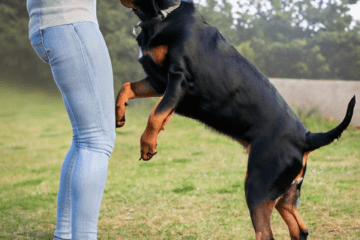‘Too much’ results in stress.
Ollie’s stress levels are at the root of the problems. This said, not all stress is bad and a lot is associated with fun – but it’s too much of everythi ng that’s the trouble.
ng that’s the trouble.
So many things add up during the day. The eighteen-month-old Cockerpoo has to have the lady in sight all the time and panics when left alone. He barks at every sound outside. He can’t control himself when other dogs are about.
Their young children are often excited around him. Too much arousal, too much petting (and too vigorous), too much prolonged, rough or repetitive play, too much physical contact. They believe it makes him happy and it does, in a way. But it’s too much.
It was evening, the children had gone to bed and Ollie gradually settled. I watched him go and snuggle on the sofa beside the man who immediately began touching him. Ollie licked his lips, then licked his nose, then yawned. A little uncomfortable? To me it suggested the dog wanted the closeness but wasn’t asking to be touched. He soon jumped down.
When they walk past him, he will roll onto his back. They assume it’s because he wants a tummy rub. Really? It will depend upon context, but often it will be appeasement. “Please leave me alone.”
Why should Ollie be so stressed?
I saw for myself how easily he becomes anxious. Sadly, as a twelve-week-old puppy, right in the middle of his first fear period, he had a painful medical problem that resulted in his being confined for six weeks.
Ollie is a lovely friendly dog. He should be having a lovely life. He has love, attention, play, walks and the best food, so why should he be stressed? It’s about everything in moderation. There is, simply, too much.
There may however be ‘too little’ of the things he really needs – down time, sniffing time, closeness without necessarily being touched, peace and quiet without being alone, brain work, healthy stimulation.
So, I would say that cutting down on the intensity of everything will make a big difference. This has to be the starting point. At the same time, we will introduce activities that help him to reduce stress and to use his brain, instead of working him up into a frenzy of excitement.
One very interesting thing they told me is that Ollie loves a tight-fitting garment they dressed him up in for an occasion last year. Recently, sniffing a box, he dug down and dragged it out. He then he took it off and lay on it. Apparently, when he was wearing it Ollie seemed calm and happy which is why they felt he liked it. This started me thinking. How does he react when his harness goes on, I asked? He’s calmer then also.
From this I just guess that there’s a good chance of him being one of those dogs a Thundershirt or Ttouch wrap could help.
Other dogs send him onto a high
Here is another strange thing. Ollie is only aggressive to other dogs when his humans are eating! If there is dog food or bones about he’s okay.
He has only ever shown aggression to humans when other dogs are around.
Ollie’s arousal levels shoot through the roof when he’s near dogs. He is so desperate to play that he overwhelms them. In his uncontrolled way, he charges about, jumping over them and has nearly bowled over a couple of owners who were not pleased. The presence of other dogs gives Ollie such a high that he’s uncontrollable. The lady is now anxious about walking him.
First things first
Number one priority, then, is to calm him down a bit. Then after two or three weeks I will go again and see what we then have and what we need to do next.


